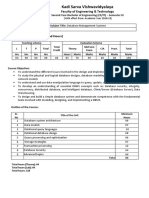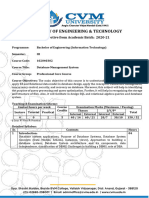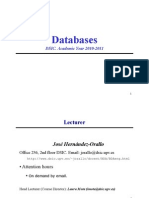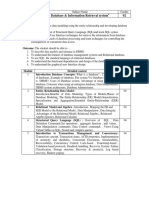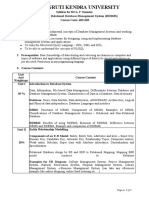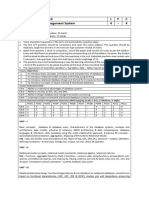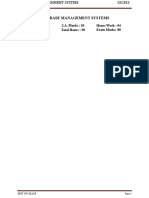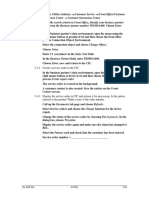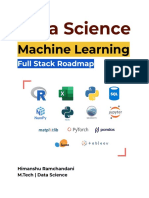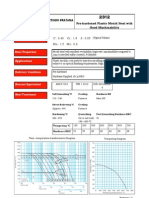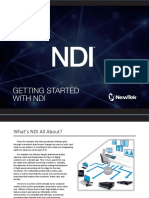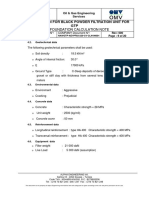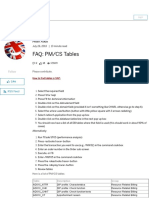Subject Syllabus
Database Management Systems
Course: B.Tech. Semester: 3
Prerequisite: Basic Computer Knowledge
Rationale: The course will enable students to understand the different issues involved in the design and implementation of a
database system as well execute various database queries using SQL.
Teaching and Examination Scheme
Teaching Scheme Examination Scheme
Lecture Tutorial Lab Internal Marks External Marks Total
Credit
Hrs/ Hrs/ Hrs/ Hrs/ T CE P T P
3 0 0 - 3 20 20 - 60 - 100
SEE - Semester End Examination, CIA - Continuous Internal Assessment (It consists of Assignments/Seminars/Presentations/MCQ Tests, etc.)
Course Content W - Weightage (%) , T - Teaching hours
Sr. Topics W T
1 UNIT-1 10 3
Introduction: Introduction and applications of DBMS, File Processing System and its limitations, ANSI/SPARC
Model, Data Independence, Client-Server Architecture, Users & DBA, Database Architecture.
2 UNIT-2 10 4
SQL: Data Definition Language (DDL) commands, Data Manipulation Language (DML) commands, Data Control
Language (DCL) commands, Transaction Control Language (TCL) commands.
Predicates & Clauses: Logical Operators (AND / OR), Relational Operators, BETWEEN Predicate, IN & NOT IN
Predicate, LIKE Predicate.
Functions in SQL: Aggregate Functions, Character Functions, Arithmetic Functions, Date Functions, Conversion
Functions.
3 UNIT-3 10 5
Data Models: Hierarchical Model, Network Model, Relational Model, Object Oriented Model.
E-R Diagram: Introduction to E-R Diagram, Entities, Attributes & its types, Relationships, Mapping Cardinalities,
Participation Constraints, Weak Entity Sets, Specialization, Generalization, Aggregation.
4 UNIT-4 10 4
Relational Data Model: Introduction, Degree, Cardinality.
Constraints & Keys: Primary Key, Foreign Key, Super Key, Candidate Key, Not Null Constraint, Check Constraint.
Relational Algebra Operations: Selection, Projection, Cross-Product, Rename, Joins (Natural & Outer Join), Set
Operators (Union, Intersection, Set Difference), Aggregate Functions.
5 UNIT-5 20 6
Relational Database Design: Functional Dependency – definition, trivial and non-trivial FD, Armstrong's
Axioms/Inference Rules, Closure of FD, Closure of Attributes, Candidate Key, Finding a Candidate Key,
Decomposition (Lossy & Lossless), Database Anomalies, Normalization – 1Nf, 2NF, 3NF, BCNF, 4NF, 5NF
6 UNIT-6 20 12
Transaction: Introduction, ACID Properties, Transaction Life Cycle, Scheduling, Serial Schedule, Interleaved Schedule,
Transaction Operations, Serializability (View & Conflict), Two-Phase Commit Protocol.
Database Recovery: Introduction, Log Based Recovery, Shadow Paging, Checkpoints.
Concurrency Control: Introduction, Lock Based Protocol, Two Phase Lock Protocol, Intention Locking, Multiple
Granularity, Time-based Protocol.
Deadlock: Introduction, Deadlock Detection, Deadlock Recovery, Deadlock Prevention (Wait-Die, Wound-Wait &
Timeout-Based Approach).
Page 1 of 2
� Subject Syllabus
Database Management Systems
7 Unit-7 10 3
Query Processing: Introduction, Layers of Query Processing, Measures of Query Cost, File Scans (Linear & Binary
Search), Materialized View, Pipelining.
Query Optimization: Introduction, Equivalence Rules, Cost-Based Query Optimization.
8 Unit-8 5 2
Security: Data Security, Data Integrity, Authentication, Authorization, Encryption, Decryption, Access Control (DAC,
RBAC, MAC), Intrusion Detection, SQL Injection
9 Unit-9 5 3
PL/SQL Concepts: Views, PL/SQL Block, Cursors, Triggers, Stored Procedures, Store Functions
Reference Books
1. Database System Concepts
By Abraham Silberschatz, Henry Korth, S. Sudarshan, McGraw Hill Publication
2. An Introduction to Database Systems
By C. J. Date, Pearson Publication
3. Programming with SQL – PL/SQL
By Ivan Bayross
Course Outcome
After Learning the Course the students shall be able to:
1. Understand basic concepts of Database.
2. Understand Relational Models and its importance.
3. Build proper structured database for a given problem or application.
4. Learn how various transactions are managed in real-time scenarios.
5. Understand the evaluation parameters of a query as well as security parameters of database.
6. Implement SQL concepts to build dynamic database applications.
Page 2 of 2

